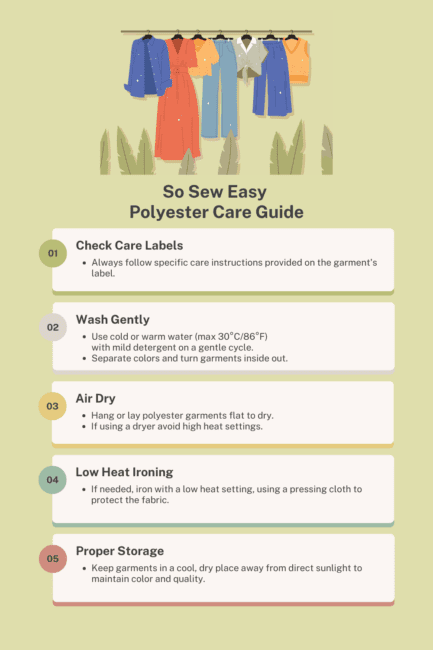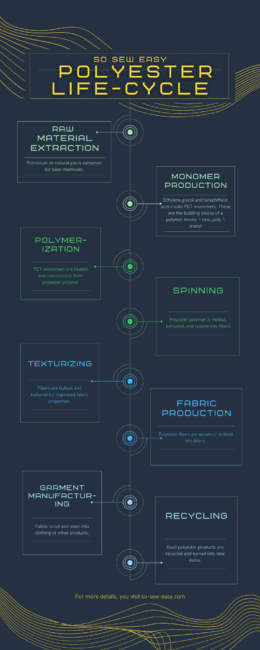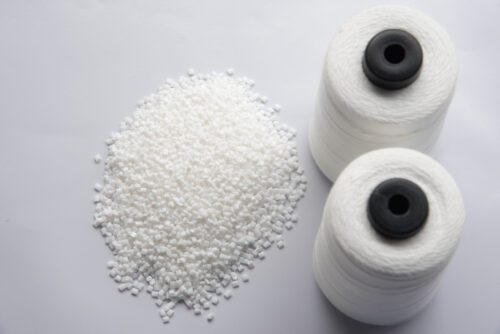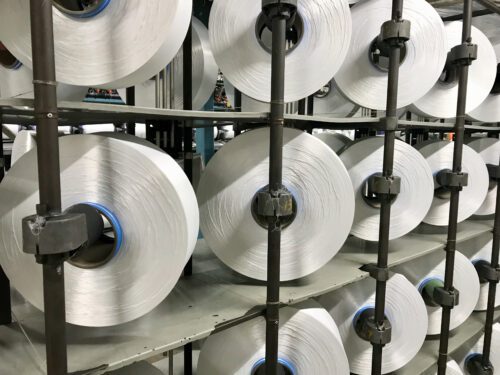
Short Answer: It Depends… (And Do At Your Own Risk!)
Just about all textiles can be shrunk to some degree. This is due to the simple nature of what fabric is: woven fibres held together by tension and friction. If you can diminish, damage, or weaken the bond between the fibers the fabric will indeed stretch out. Different textiles respond in different ways, with polyester responding best (since it is a plastic), to heat.
Polyester is a synthetic fabric that is made from petroleum-based materials. When exposed to heat, the fibers can shrink, causing the fabric to become smaller. The heat can also cause the fabric to lose its shape and become distorted. If you have ever accidentally put a polyester garment in the dryer on high heat, you may have experienced this phenomenon firsthand.


Though polyester is know for being resistant to shrinking, if you need to shrink a polyester garment, you can try the following steps:
- Fill a large pot with water and bring it to a boil.
- Immerse the polyester garment completely in the boiling water. Use a long-handled utensil to avoid burning yourself.
- Let the garment soak in the boiling water for about 5 to 10 minutes. Keep an eye on it and stir occasionally to prevent it from sticking to the bottom of the pot.
- After 5 to 10 minutes, remove the garment from the boiling water using tongs or a long-handled utensil.
- Rinse the garment in cold water to stop the shrinking process.
- Gently wring out any excess water and hang the garment to dry.
Keep in mind that this method may not work for all polyester fabrics and may cause the garment to lose its shape or texture. It's important to test a small, inconspicuous area of the garment first to see how it reacts to boiling water.
Polyester Care Guide
To care for your polyester clothes and prevent unwanted shrinking and wear, it is important to follow the care instructions on the garment label. Most polyester garments can be machine washed on a gentle cycle with cool or warm water. It is best to avoid using hot water or high heat in the dryer, as this can cause the fabric to shrink and damage the garment. Hanging polyester garments to dry or using a low-heat setting in the dryer can help prevent shrinkage.


In addition to washing and drying, it is also important to store your polyester clothes properly. Hanging them in a closet or folding them neatly in a drawer can help prevent wrinkles and distortion. Avoid storing your polyester clothes in direct sunlight or in damp environments, as this can also cause damage to the fabric.
What Is Polyester?
Polyester is a synthetic fabric that is made from a blend of chemicals, including ethylene glycol and terephthalic acid. These chemicals are melted and spun into fibers, which are then woven into fabric. Polyester is known for its durability, wrinkle resistance, and low maintenance. It is also a popular choice for athletic wear and outdoor clothing, as it wicks away moisture and dries quickly.


The recycling process for polyester involves collecting, sorting, cleaning, shredding, melting, spinning, and weaving the polyester waste into new products. The resulting recycled polyester fabric or product can be used in various applications, such as clothing, upholstery, and packaging.


The collection stage involves gathering polyester waste from various sources, such as post-consumer garments, industrial waste, and scrap material from the manufacturing process. The waste is then sorted by color, composition, and type of material, and cleaned to remove any impurities such as dirt, oil, and other contaminants. The cleaned polyester waste is shredded into small pieces or flakes, melted at high temperatures, and extruded through small holes to form new polyester fibers. The fibers are spun into yarn or thread, which is then woven into fabric or other products.
Where Are Polyester Garments Made And Sold?
Polyester garments are primarily made and sold in Asia, particularly in China, India, and Bangladesh. These countries have a large textile industry and produce a significant amount of polyester fabric and garments. Polyester is also commonly used in home sewing, as it is an affordable and versatile fabric.
According to the latest data available from the United Nations, the top three polyester producing countries in the world are:
- China – In 2020, China produced around 29.7 million metric tons of polyester, which accounted for around 60% of the world's total production.
- India – In the same year, India produced around 6.2 million metric tons of polyester, making it the second largest producer in the world.
- United States – The United States produced around 2.6 million metric tons of polyester in 2020, making it the third largest producer globally.
It is worth noting that polyester production is concentrated in Asia, with China and India alone accounting for around 70% of the world's total production. Other countries that produce significant amounts of polyester include South Korea, Taiwan, and Indonesia.


According to the latest data available from the United Nations, global polyester consumption has been steadily increasing over the past decade. In 2010, the world consumed around 47.5 million metric tons of polyester. By 2019, this figure had increased to around 60.3 million metric tons, representing a growth of around 27% over the period.
The Asia-Pacific region is the largest consumer of polyester, accounting for around 88% of the world's total consumption. China is by far the largest consumer of polyester, accounting for around 65% of the world's total consumption. Other major consumers of polyester include India, Indonesia, and Vietnam.
Sewing With Polyester
When sewing with polyester and polyester blends, it is important to choose the right needle and thread. A sharp needle and a polyester thread can help prevent the fabric from fraying and breaking. It is also important to use the right stitch length and tension when sewing, as a too-tight stitch can cause the fabric to pucker and a too-loose stitch can cause the fabric to stretch.
Polyester Sewing Projects
There are many fun and creative sewing projects that can be made with polyester fabric. From dresses and skirts to bags and home decor, polyester is a versatile fabric that can be used in a variety of projects.
Athletic Wear: Polyester fabric is a popular choice for making athletic wear such as running shorts, sports bras, and workout leggings because it's lightweight, breathable, and moisture-wicking.
Swimwear: Polyester fabric is commonly used for making swimwear because it's quick-drying, chlorine-resistant, and can withstand exposure to sun, saltwater, and sand.
Raincoats: Polyester fabric is a great choice for making raincoats because it's water-resistant and can provide protection from the rain. It's also lightweight and can be packable, making it a convenient option for traveling.
Lining Fabric: Polyester fabric is commonly used as a lining fabric in garments such as jackets, coats, and skirts because it's lightweight, durable, and can prevent the outer fabric from wrinkling. It's also easy to clean and can provide additional warmth.
Aprons: Polyester fabric is ideal for making aprons because it's durable and easy to clean. Plus, it's available in a variety of colors and patterns to match any kitchen decor.
Tote Bags: Polyester fabric is a great choice for making tote bags because it's sturdy and can hold up to wear and tear. Plus, it's easy to clean and can be water-resistant.
Cushion Covers: Polyester fabric is an ideal choice for making cushion covers because it's durable and easy to clean. Plus, it's available in a wide range of colors and patterns to match any decor.
The Future Of Sewing With Synthetic Materials
The future of synthetic materials in fashion and home sewing is a topic of much debate. While polyester and other synthetic fabrics are affordable and durable, they also have a negative impact on the environment. Synthetic fabrics are made from non-renewable resources and can take hundreds of years to decompose in landfills. As consumers become more aware of the impact of their choices on the environment, there may be a shift towards more sustainable and eco-friendly fabrics.








I LOVE these informative articles! Often things I’ve wondered about, they are so welcome. I am 70, and if you’re lucky, you learn something every day! Thank You!!
HI Jeanette, very happy you enjoy them.
Some times polyester does shrink still, especially a poly blend. If it were only my things, I would assume I put on weight, but my husband’s knit shirts will shrink in the dryer on warm. I just hang those items out to dry.
How do wicking fabrics allow you to stay cool? They are primarily polyester.
It is all in the weave, I am in the process of writing about it but I have to make some drawings to be able to explain correctly so stay tuned and soon you will find out.
I have a front load Bosch washer. I have to be careful to wash on a delicate cycle or slower speeed otherwise the item gets deep wrinkles and do not want to come out. Polyester has come a long way. Sometimes it is a dead ringer for silk.
Wonderful piece! Have used since the 60s when it was “cool”, but the refinements technologically have been incredible.
Love it and hate it, then love it: 🙂
Made a recent purchase of polys for ballroom dresses…and you by one stroke of an enewsletter today, helps immensely!
Thanks Myra, for continually giving of yourself to we folks out here in “wherever-land” !
You are most welcome Diane!
Why does my 100% polyester blouse say dry clean only?
A label in the back of a garment says more when something is omitted than when it is not. Polyester can be either dry cleaned, hand washed or machine washed. The manufacturer needs to point at the best alternative for care of the product. Is your blouse silky? The filament to simulate silk is achieved in polyester and laundering such a blouse will shorten its lifespan. This is a huge topic and would make a good post, Thank you for your question, I will write deeper about the subject.
Sometimes it is not because of the type of fabric the garment is made of but because of the way it is sewn or the embellishments used.